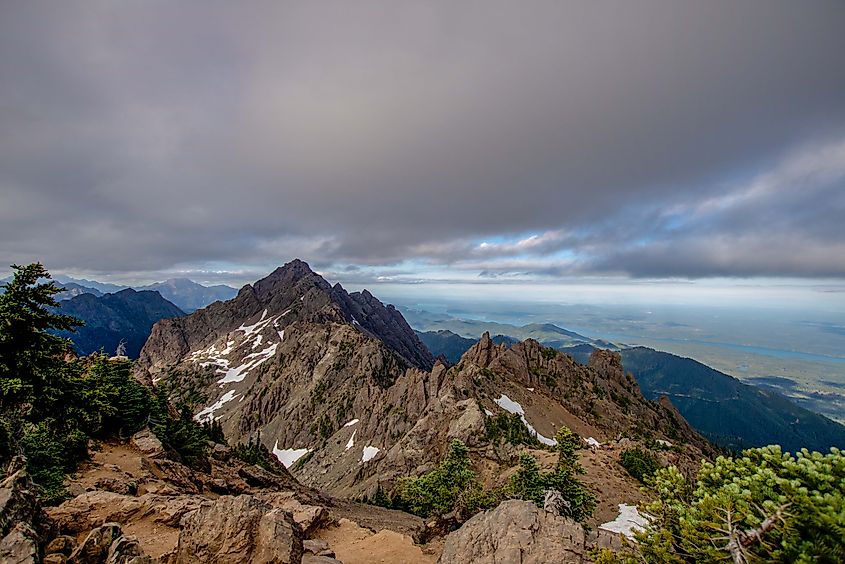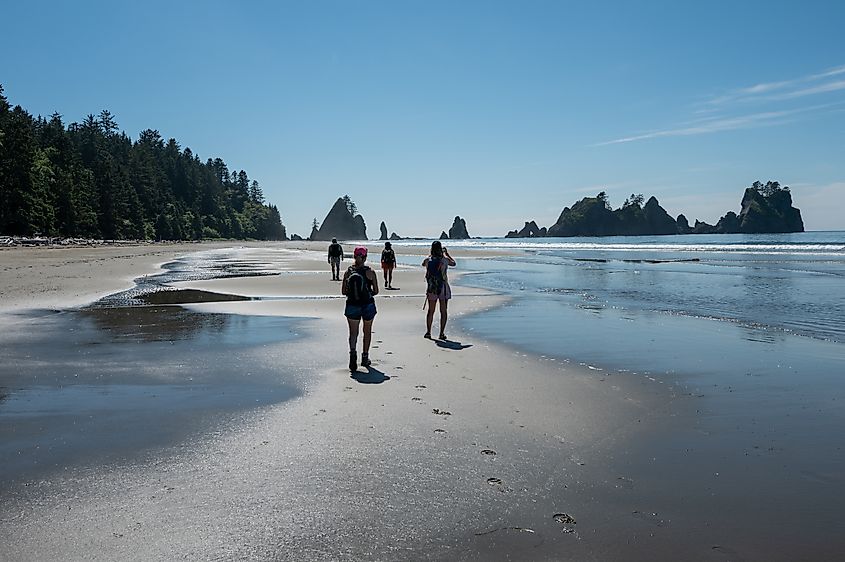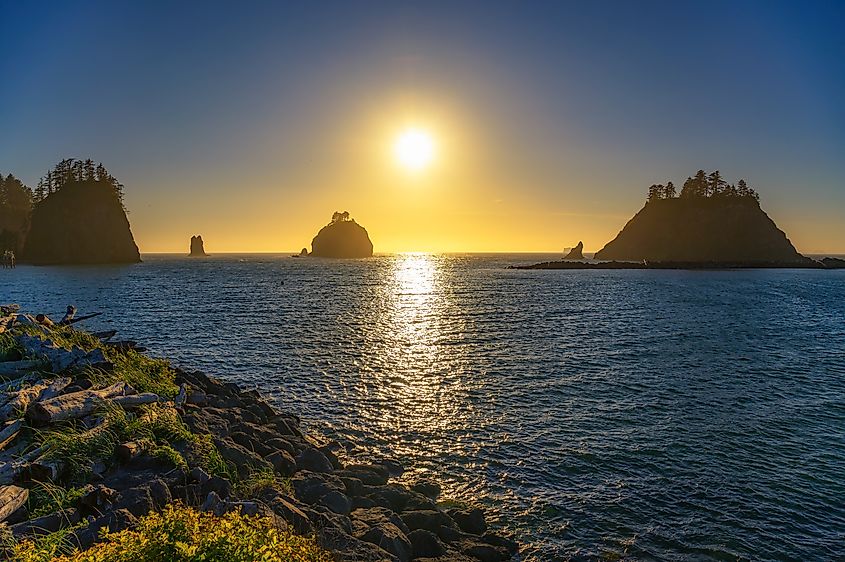
Olympic National Park Encircles Three Ecosystems: Rainforest, Coastline, and Glacier Peaks
Olympic National Park contains one of the most ecologically diverse landscapes in the United States, all located on Washington’s Olympic Peninsula. The park spans nearly 1 million acres and includes coastline, temperate rainforests, and alpine highlands within a relatively compact area.
This unusual convergence of ecosystems is shaped in large part by the Olympic Mountains, which influence weather patterns and isolate various habitats across the land and water, allowing anything from gigantic trees to rare chipmunks to thrive. Within a single day here, you can walk among moss-covered woodlands that look like something out of Star Wars, climb into subalpine meadows bursting with wildflowers, and end the day on a lonesome Pacific beach.
With that in mind, let's break down these major ecosystems and highlight what makes each one distinct and worth exploring during your next visit to this beloved park in the Pacific Northwest.

Touch the Sky in the Olympic Mountain Range
This high country in Olympic National Park remains remote and rugged for the most part, preserving one of the last truly wild alpine environments in the Pacific Northwest. The glacier-covered peaks of the Olympic Mountains form the park’s highest and most dramatic zones. With its tallest point, Mount Olympus, standing at 7,980 feet, these alpine summits are notable for their centuries of accumulation of ice and snow. Blue-tinted glaciers, including that aptly named Blue Glacier on Mount Olympus, serve as essential freshwater sources for the surrounding ecosystems, adding to their importance on the peninsula.

Harsh conditions, including high winds, short growing seasons, and heavy snowfall, limit vegetation to hardy alpine grasses, mosses, and wildflowers that bloom briefly in summer. In terms of fauna, the animals that call these heights home tend to be more specialized and sparse, with species like the Olympic marmot and mountain goat adapted to the thin air and cold temperatures.
These peaks also influence the entire park’s overall climate and biodiversity by creating a rain shadow, forming drier woodlands on the eastern slopes, and to the west, catching rainfall, which leads to the rainforests that exemplify the region's lower elevations.
How to Get the Best Views of these Mountains
To best experience this lofty portion of the park, start at Hurricane Ridge, one of the park’s most accessible high-altitude areas. The visitor center here can be reached by road and offers panoramic views, with access to a few nearby trails, too.
For a closer look at alpine ecosystems, the Hurricane Hill Trail provides a moderate hike, tons of viewpoints, and chances to spot Olympic marmots. For more experienced hikers, the High Divide Loop near the Hoh Rain Forest climbs into glacier-fed basins with clear views of Mount Olympus and its icefields. Mountaineers seeking a challenge can also arrange backcountry permits and attempt glacier travel with proper gear and know-how.

Note that visiting between July and September is recommended, as the trails are usually free of snow, wildflower blooms happen in this window, and stable weather conditions are more common in this often fragile, high-altitude environment.
See an Incredibly Green and Lively Landscape in Olympic's Rainforests

This peninsula's temperate rainforests are among the most diverse and visually unique ecosystems in the world, grown thanks to heavy rainfall and the mild coastal temperatures of the PNW. Primarily found on the park’s western side, the Hoh, Queets, and Quinault Valleys receive up to 170 inches of precipitation annually. This creates incredibly lush, moss-draped forests dominated heavily by Sitka spruce, western hemlock, and bigleaf maple.
These rainforests also support a dense understory of ferns, lichens, and deadfall that host entire micro-communities of fungi and insects. Bigger animal species, including the park's iconic Roosevelt elk, black bears, and a variety of amphibians that thrive in the damp environment, can also be spotted. Furthermore, these forests are critical carbon sinks, playing a vital role in climate regulation for the region.
Fog and moisture help maintain biodiversity and slow decomposition, too, resulting in a landscape that feels ancient and undisturbed, something that is best felt with an in-person excursion.
Where Can You Walk Amongst These Verdant Landscapes?

Find your own adventure in the Olympic rainforests at previously mentioned places like the Hoh Rain Forest, which is the most accessible and iconic option. Located off US Highway 101, the Hoh Rain Forest Visitor Center provides you with info and a gift shop before exploring the area's nearby network of footpaths. The short Hall of Mosses Trail takes you on a walk around ancient trees draped in greens of all shades, while the longer Hoh River Trail allows its hikers to venture deeper into the forest along a glacier-fed river.
For a more remote stroll, the Queets and Quinault rainforests often have thinner crowds yet equally rich biodiversity, though access may be more limited.
Wherever you go, try to visit during spring or fall for peak moss growth and fewer fellow visitors, and be sure to bring solid waterproof gear, as these forests remain quite damp even in summer.
Explore the Park's Quiet and Often Mist-Draped Oceanfront

Olympic National Park’s coastline stretches 73 miles along the Pacific Ocean, forming one of the longest undeveloped shorelines in the contiguous United States. It is remarkable for its powerful tides, sea stacks, and shifting sands, resulting in an ecozone of tidepools, driftwood-covered beaches, coastal forests, and a reputation among landscape photographers around the world.
A stroll along just about any of the local beaches will take you near marine life like sea stars, anemones, mussels, and crabs, while further offshore are habitats for sea otters, seals, and migrating whales. Look up and you may see bald eagles and shorebirds frequenting the skies, searching for fish and smaller marine creatures to feed on.
Inland from the beachfront, oceanside shrubs, grasses, and wind-blown trees transition into dense coastal forests, where large trees tower above it all, and a number of campsites can be enjoyed. The Kalaloch Campground is particularly popular, being easy to reach and sitting right on the transition zone from sand to woods. At this site, you will also be able to witness the "Tree of Life," a wacky-looking Sitka spruce with roots precariously reaching between a large gap in the bluffs.
Soak in the Sights on the Pacific Coastline

There are many great points along the way to get a clear view of the ocean. For a few suggestions, head to Rialto, Second, or Ruby Beach, each accessible by car and featuring numerous tidepools and sizable sea stacks. For a deeper exploration, the Ozette Triangle Loop combines coastal hiking with inland forest, boasting ancient petroglyphs at Wedding Rocks and primitive campsites, too.
Those more prepared for backcountry travel can explore the longer coastal routes between Shi Shi Beach and Cape Alava, which require permits and bear canisters.
Morning fog on the Olympic coastline often gives way to clear afternoons, ideal for wildlife viewing and unique conditions for photography throughout the day. And as with other parts of the park, coastal weather here is variable, so bring layers and waterproof gear, whether you are on the coast for a quick day trip or spending the night under the stars.
See Three Worlds in One Day

One of the most special things about Olympic National Park is its sheer diversity, from desolate glaciers to rain-drenched woodlands teeming with life. Better yet, you can easily see all of these in one fairly easy day, driving from the high reaches of Hurricane Ridge to the sandy beaches down below on the park's web of roads and highways.
Regardless of what your plans are, whether driving in from Seattle for a quick afternoon outing or flying in for an extended stay, you will now be able to experience this renowned national park with a bit more info about its natural wonders in hand.











